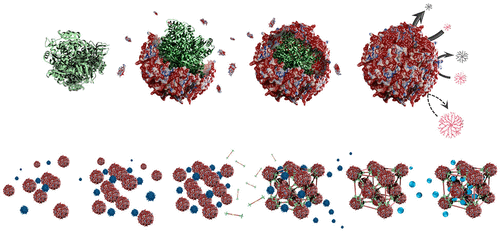当前位置:
X-MOL 学术
›
Acc. Chem. Res.
›
论文详情
Our official English website, www.x-mol.net, welcomes your
feedback! (Note: you will need to create a separate account there.)
Bioinspired Approaches to Self-Assembly of Virus-like Particles: From Molecules to Materials
Accounts of Chemical Research ( IF 16.4 ) Pub Date : 2022-05-04 , DOI: 10.1021/acs.accounts.2c00056 Yang Wang 1 , Trevor Douglas 1
Accounts of Chemical Research ( IF 16.4 ) Pub Date : 2022-05-04 , DOI: 10.1021/acs.accounts.2c00056 Yang Wang 1 , Trevor Douglas 1
Affiliation

|
When viewed through the lens of materials science, nature provides a vast library of hierarchically organized structures that serve as inspiration and raw materials for new synthetic materials. The structural organization of complex bioarchitectures with advanced functions arises from the association of building blocks and is strongly supported by ubiquitous mechanisms of self-assembly, where interactions among components result in spontaneous assembly into defined structures. Viruses are exemplary, where a capsid structure, often formed from the self-assembly of many individual protein subunits, serves as a vehicle for the transport and protection of the viral genome. Higher-order assemblies of viral particles are also found in nature with unexpected collective behaviors. When the infectious aspect of viruses is removed, the self-assembly of viral particles and their potential for hierarchical assembly become an inspiration for the design and construction of a new class of functional materials at a range of different length scales.
中文翻译:

类病毒颗粒自组装的仿生方法:从分子到材料
从材料科学的角度来看,大自然提供了一个庞大的分层组织结构库,可作为新合成材料的灵感和原材料。具有高级功能的复杂生物体系结构的结构组织源于构建块的关联,并得到普遍存在的自组装机制的强烈支持,其中组件之间的相互作用导致自发组装成定义的结构。病毒是示例性的,其中通常由许多单独的蛋白质亚基自组装形成的衣壳结构用作运输和保护病毒基因组的载体。在自然界中也发现了具有意想不到的集体行为的病毒颗粒的高阶组装。当病毒的传染性方面被去除后,
更新日期:2022-05-04
中文翻译:

类病毒颗粒自组装的仿生方法:从分子到材料
从材料科学的角度来看,大自然提供了一个庞大的分层组织结构库,可作为新合成材料的灵感和原材料。具有高级功能的复杂生物体系结构的结构组织源于构建块的关联,并得到普遍存在的自组装机制的强烈支持,其中组件之间的相互作用导致自发组装成定义的结构。病毒是示例性的,其中通常由许多单独的蛋白质亚基自组装形成的衣壳结构用作运输和保护病毒基因组的载体。在自然界中也发现了具有意想不到的集体行为的病毒颗粒的高阶组装。当病毒的传染性方面被去除后,









































 京公网安备 11010802027423号
京公网安备 11010802027423号